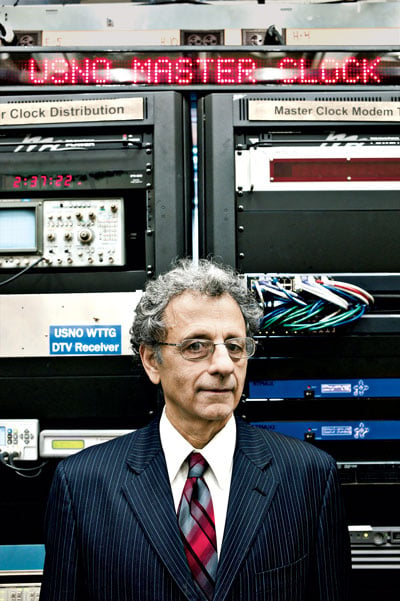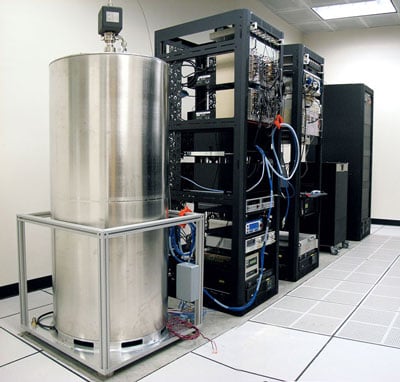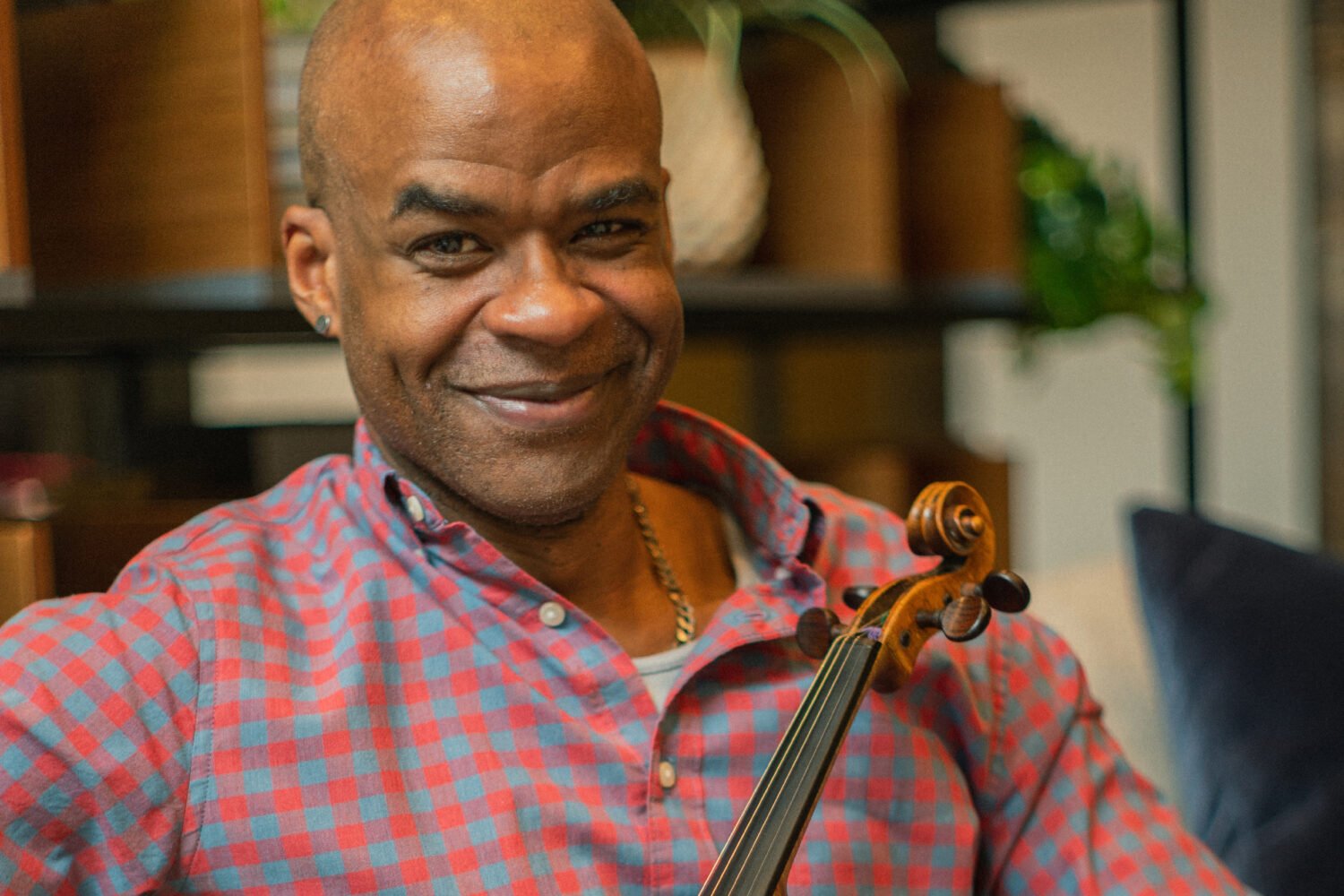
Unlike most scientists, Demetrios Matsakis happily admits he has a “crackpot theory.” In fact, he’s eager to test it on me. I’m standing in a hallway near his office, facing a large window and looking into a room filled with multiple towers of electronics. Each device helps keep precise time, but out of all the dials, displays, and wires snaking about, I’m concentrating on a tiny screen that flashes once a second. Blip . . . blip. Meanwhile, I’m pressing a telephone to my ear, waiting for a beep. On the phone, an actor—Fred Covington, whose photograph hangs nearby—reads off the time. “At the tone . . . 16 hours, 12 minutes, five seconds”—beep. Matsakis smiles and asks me to judge which comes first, the blip or the beep.
Matsakis has a sly sense of humor: Jokes bubble up unexpectedly, and I can’t always tell when he’s making one—including now. He runs the Time Service Department at the US Naval Observatory, which keeps official time for the country. Without his department’s ultra-precise clocks, the Global Positioning System (GPS), cell phones, and the Internet would flounder, but few people even know the department exists.
Most visitors here are either fellow time geeks or officers interested in military applications. And after years of informally testing visitors, Matsakis theorizes that each camp has its brains wired differently. Military people generally see the blip first, he suggests, because they need to scan quickly for danger. Scientists, working in less perilous situations, hear the beep first. Now Matsakis wants to classify me.
I concentrate, but the beeps and blips seem to alternate, one arriving first, then another. Because that sort of averages out, I tell Matsakis they seem simultaneous. He appears satisfied with this, but I feel I’ve proved myself unfit for both science and soldiering. Or maybe Matsakis is messing with me. (Months later he informs me that, having gathered additional data, he’s rejected his theory about military people and scientists.)
Regardless, there’s a serious lesson behind the exercise. The beep and the blip are both wired into the US Master Clock, so they really are simultaneous. But many people have trouble sensing that. In fact, humans stink at keeping time on their own. We’ve all had days when the hours flit along like thoughts and others when time drags like an anchor. That’s why we’ve always used celestial bodies or mechanical clocks to track time.
But the clocks Matsakis works with vastly exceed the precision that any human could detect. Official US time usually drifts less than 0.0000000001 second (one-tenth of a nanosecond) per day. Satellites and computers need to track time on that scale, and they’re constantly bugging the Time Service Department for updates. Indeed, the department probably intersects with more people’s lives each day than any other government agency. Yet the only time the public notices is when something goes wrong.
Most Washingtonians probably think of official US time, if they think of it at all, as that clock with red numbers outside the Naval Observatory on Massachusetts Avenue, Northwest. You might have adjusted your dashboard clock to it at a stoplight. But that’s one of the least precise pieces of equipment the Time Service Department runs. The real time-geek goodies sit behind the guard depot and wrought-iron fence.
The security checkpoints protect not the Time Service Department—though it does house classified military equipment—but the Vice President, who also resides on the USNO campus. (Al Gore often dropped by the observatory to peer through telescopes.) Beyond the security, the campus is bucolic—full of trees, meandering roads, and occasional deer. The low buildings would look almost like an old-fashioned town but for the gargantuan satellite dishes out front that push time signals into space.
The devices that keep official US time sit in environmentally controlled chambers down the hall from Matsakis’s office. They look nothing like typical wall clocks with gears and springs. Some of the devices are hydrogen masers, which are similar to lasers. They look like an airplane drink cart might if it were designed by Brink’s—thick, black, imposing, and on wheels. They weigh more than 500 pounds, and only a time display in front betrays them as clocks.
The other main type of timepieces, cesium clocks, are stacked in a separate room in what look like refrigerators with glass doors. Both devices keep time essentially by counting. In cesium clocks, a beam of light strums a certain electron inside some cesium atoms, causing the electron to oscillate back and forth unthinkably quickly—9,192,631,770 times a second. Scientists know it takes 9,192,631,770 flip-flops because they’ve defined one second as that many flip-flops—which explains why Matsakis can rattle that number off in roughly a nanosecond himself.
Masers are sprinters, best at keeping time over the short term—a few days—while cesium clocks keep better time over weeks and months. Official US time incorporates readings from both—around a dozen masers and a few dozen cesiums. But because each clock ticks ever so slightly differently, the Time Service Department has picked one maser as the clock and uses other devices to tweak its output every hour.
This ensemble of devices, collectively called Master Clock 2, keeps official US time, and it has ticked continuously, every second of every minute of every hour, since 1995. (There used to be a Master Clock 1 as well, and the Time Service Department alternated between the two. When the decision was made to stop doing that, Master Clock 2 happened to be running things, so it stayed on as the official clock.) Backup master clocks sit in other buildings around campus, Matsakis says, “so if one building burns down, another keeps ticking.”
Defining time with MC2 is only half the job. The department also pushes time out to the public so the rest of us can at least approximate its precision. The least precise method of disseminating time is the telephone. If you dial 202-762-1401, Fred Covington will read the time to you. He’s best known as the auctioneer in Roots, but the movie website IMDb does credit him with reading USNO time. Reciting the entire 24-hour day in five-second intervals took Covington multiple days of taping in 1978; his voice does sound smoother than typical call-in services. Dialing in and listening for beeps might seem archaic—too imprecise for a digital age—but Americans still ring Fred up 4 million times every year. It might be the most repeated performance in history.
For higher precision, USNO disseminates time over the Internet. If left unchecked, internal computer and server clocks can drift by several minutes a month, which could lead to quarrels over, say, when stock trades went through or whether someone submitted his taxes on time. For that reason, most computers and servers synchronize with official US time every hour or so.
Even more sophisticated is the equipment that helps set time for GPS. (The GPS Master Control Station—located on Schriever Air Force Base in Colorado—keeps its own clock, but USNO corrects and updates it.) GPS devices detect signals from multiple satellites and use the time differences among those signals to calculate position. For every nanosecond of uncertainty in when the signals arrive, that accuracy drops. USNO also provides time information for military satellites that need even higher resolution, but Matsakis declines to elaborate.
The various clocks that define US time mostly tick along without intervention. They certainly don’t need winding. Still, there’s a chronic, smoldering fear that something will go awry—that time will be lost.

Temperature fluctuations change how clocks keep time, especially masers. For that reason, if the temperature fluctuates by more than two-tenths of a degree Fahrenheit inside the chamber that houses MC2’s main maser, a security system will send out e-mails, pages, and calls to department officials. Three times in his tenure, Matsakis has gotten a message that the clock failed—once at his son’s wedding, twice while sitting on a plane about to take off. Each time he had to sweat out the fluctuations from afar while his staff got things under control.
The Time Service Department also sometimes causes chaos in the wider world, albeit inadvertently. If you noticed Reddit, Yelp, or Gawker seize up and crash not long after 8 pm on June 30, you can blame the leap second that the department inserted into official US time right around then.
Matsakis has the perfect background to handle leap seconds. He came to USNO as a physicist in 1979 to study the earth’s rotation. Ten years later, his boss asked him to help develop a mercury-based clock to keep accurate time. Matsakis never got the thing running, and, deciding he just wasn’t a time guy—he doesn’t wear a watch and never has—after six months asked to be reassigned. But his boss said no, and Matsakis says he eventually got “seduced” by the challenge of measuring time more and more precisely.
The leap second combines Matsakis’s old interest with his new one. A leap second is like a short leap day, except it’s introduced for different reasons. We add leap days because Earth doesn’t orbit the sun in exactly 365 days; it takes closer to 365¼ days, and we have to account for that extra fraction every four years.
We add leap seconds because Earth’s rotation is slowing down due to tidal friction with the moon. It slows just a fraction of a millisecond each year, but milliseconds add up. In dinosaur times, days lasted 23 modern hours. Around 1820, days lasted exactly 24 hours, and days now last 2.5 milliseconds longer. So to keep ground-based clocks synchronized with Earth’s rotation, time scientists such as Matsakis insert a leap second every third year or so. A good digital clock on June 30 should have read 7:59:59 pm, then 7:59:60 pm (the leap second), then 8:00:00 pm.
Should have. Not even the USNO clock on Massachusetts Avenue got the memo—it hopped right over the leap second. And some computer systems had outright meltdowns when they checked the time via the Internet and confronted 7:59:60. Indeed, there are regular calls to abolish the leap second, in part because of the havoc it wreaks. Previous leap seconds have KO’d Linux and Oracle systems. And when Qantas computers checked in with Australia’s official time on June 30, their software went haywire, too. Airline passengers couldn’t check in, and planes were grounded worldwide. Hours of headaches followed because of one measly second.
USNO got involved in official timekeeping in a roundabout way. Ships always needed precise time to calculate longitude, their east/west position. So the Naval Observatory—which was in Foggy Bottom then—erected a huge brass-colored orb on its roof and, starting in 1845, dropped it every day at exactly noon—the forerunner of today’s New Year’s Eve ball. Ships sailing on the Potomac River could then set their clocks by it.
Washingtonians could set their clocks by the orb, too, helping solve another problem. Through much of the 1800s, every city kept its own time, called local time, based on the sun’s position at noon. New York ran five minutes ahead of Philadelphia, which ran seven minutes ahead of Washington. But as the century advanced, local time became a headache, especially for railroads with schedules to maintain. At first, railroads kept their own “train time” inside the cars, but this caused even more confusion because lines would run on different clocks than the towns they passed through. Eventually, the railroad lobby succeeded in standardizing US time, creating the large time zones we know today. Because of its experience, USNO became the nation’s official timekeeper.
Matsakis clearly enjoys this history of timekeeping. He has a grandfather clock—the gold standard of the 1800s—outside his office, and his department dropped the giant orb atop the observatory to ring in the new year in 2000 and 2001. But he’s also helping push timekeeping forward, because even though no human will ever be able to detect the difference, measurement still can get more exact.
A new USNO building houses the next generation of ultra-precise timepieces, rubidium fountain clocks—so named because rubidium atoms whoosh upward in a cascade inside them. Because they’re more precise, rubidium clocks will eventually supplant cesium clocks in the official US time calculation. And the rubidium clocks do look fittingly futuristic—tall, shiny, seamless cylinders. The building also has elaborate features to boost their performance. Each timepiece rests on a metal square that isolates it vibrationally from the earth to mitigate against earthquake tremors.
The building has some quirks, though. Temperature fluctuations can ruin the precision of rubidium clocks, so staff members have spent more than a year testing the building’s air conditioning. During one test run, the cooling system worked too well, and, just like on a weather map, a cold front swept in and condensation formed inside the clock chamber, producing indoor snow. Another time, Matsakis saw what looked like spilled coffee near the clocks. “Coffee makes the clocks run fast,” he joked, but in truth the situation was worse: The “coffee” was mud that had soaked through the ceiling tiles due to a leaky roof.
Even when the climate control gets fixed, Matsakis’s team can’t relax. The rubidium clocks, he says, are accurate to 16 decimal places, allowing USNO to make the most precise continuous time measurements in history. But to do that, they have to keep the clocks running without a hiccup for every nanosecond of every minute of every month of every year from now until . . . forever.
The burden never eases. “People who have retired tell me this,” says Matsakis. “You don’t realize while you’re here, but you’re always afraid of losing time. It’s always in the background. It must be like living in California and always worrying a little about an earthquake. When they retire, they finally feel relaxed. I suspect I’ll be the same.”
Sam Kean is author of the book The Violinist’s Thumb, about lost historical tales buried in human DNA. An excerpt is at samkean.com.
This article appears in the December 2012 issue of The Washingtonian.















